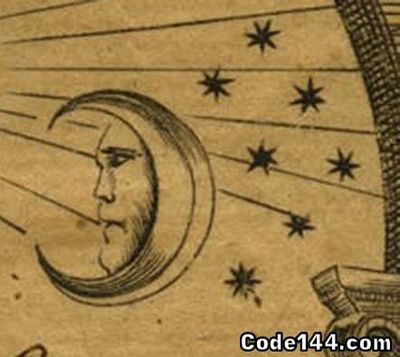Annotation:Seven Stars
X:1 T:Seven Stars, The T:Moon and Seven Stars, The M:6/8 L:1/8 R:March S:Thomas Nixon music manuscript collection, c. 1778 N:Nixon (1762-1842) was a fifer in the American War of Independence, N:from the age of 13. He lived in Framingham, Connecticut. Z:AK/Fiddler’s Companion K:D d3 AGF|GAB A3|Bcd efg|fed cBA| d3 AGF|GAB A3|Bcd efg|Adc d2:| |:e2A A2f|efg f3|efg fed|cec A3| Bac AFA|Bac AFA|Bde efg|Adc d2:|]
SEVEN STARS. AKA and see “Grand Parade (1) (The),” "Moon and Seven Stars (The)." English, Country Dance Tune (6/8 time). England; Northumberland. D Major. Standard tuning (fiddle). AABB. The ‘seven stars’ are the constellation of the Pleiades, the seven sisters, easily found in northern hemisphere skies. "Seven Stars" is one of the "missing tunes" from William Vickers' 1770 Northumbrian dance tune manuscript. Knowles (1995) and Callaghan (2007) remark that the tune is a popular jig, then and now, found in many northern English manuscripts. An influential version appears in the c. 1798 Joshua Jackson (1763-1839) manuscript from north Yorkshire, a version many modern fiddlers learned after it was included on the “Trip to Harrowgate” album. It also appears in the 19th century music manuscripts of the Matthew Bethan (Towcett, Cumbria, 1815), Rev. Robert Harrison (Brampton, Cumbria, 1820), the Hardy family (Dorset), William Vickers (Northumberland, 1770), Laurence Leadley (Thirsk, North Yorkshire, as “The Grand Parade”), Joshua Jackson (north Yorkshire) and John Winder (Wyresdale, Lancashire, 1789). James Aird included the melody in his Selection of Scotch, English, Irish and Foreign Airs, vol. 1 (1782, p. 4), published in Glasgow, Scotland. Its origins, however, can be traced to David Rutherford's Compleat Collection of 200 of the Most Celebrated Country Dances, vol. 1 (p. 11), published in London in 1756. Charles and Samuel Thompson published it again in 1780 in Thompson’s Compleat Collection of 200 Country Dances, vol. 4. The tune (sometimes as "The Moon and Seven Stars") was very popular in America after the Revolutionary War, with the Elisha Belknap (Framingham, Mass., 1784), Ira Clark (Simsbury, Conn., c. 1801), Micah Hawkins (New York, 1794), Luther Kingsley (Mansfield, Conn., 1795-c. 1815), Thomas Nixon (Danbury, Conn., c. 1776-1778) and Whittier Perkins (Massachusetts, 1790) manuscripts dating between 1776 and 1801 all listing the tune. See also note for "The Moon and Seven Stars."

The “Seven Stars” melody appears in the music manuscript collection of the brothers Bast, from Denmark, compiled during the years 1763-1782. In 1782 one of the brothers entered the priesthood, and presumably gave up recreational music at that time. It appears in their copybook under the title “Frederiks kontra.” The American variant title, “The Moon and Seven Stars,” is perhaps derived from freemasonry, writes New Hampshire fiddler Randy Miller, “where the moon rules the night, and the seven stars signify the Seven Sisters, the Pleiades star cluster, as well as the seven-day division of time.”
An inn called the Seven Stars in Withy Grove, Manchester, purports to be one of the oldest inns in existence, with documents indicating it was a hostelry prior to 1356. The name was a popular one, however, as there were many such-named, particularly in Cornwall. An establishment at Prestwich, England, was known by the title Same Yet, but was formerly known as the Seven Stars. At some point it had become necessary for the old sign of the Seven Stars to be repainted due to fading, and when the painter asked the landlord what he was to put upon the board he received the answer “The Same Yet.” And the man took him at his word (Hawkwood, 1909). There was also the The Moon and Stars in Norwich, The Half Moon and Star in Ipswich and The Half Moon and Seven Stars in Brentford[1].
'The moon and seven stars' also was used as the symbol for 18th century traders tokens, and as a masonic symbol. The phrase "The moon and seven stars are against us" was in use from the 16th century, with the seven stars perhaps referring to the stars that form the Big Dipper constellation rather than the Pleiades, the major stars of Orion or the seven planets. The phrase historically refers to the hopelessness of trying to change the course of nature. There are even Roman coins from several reigns that depict a crescent moon and seven stars on one side.
- ↑ Classified by G.A. Tomlin, "Pubs", 1922.

